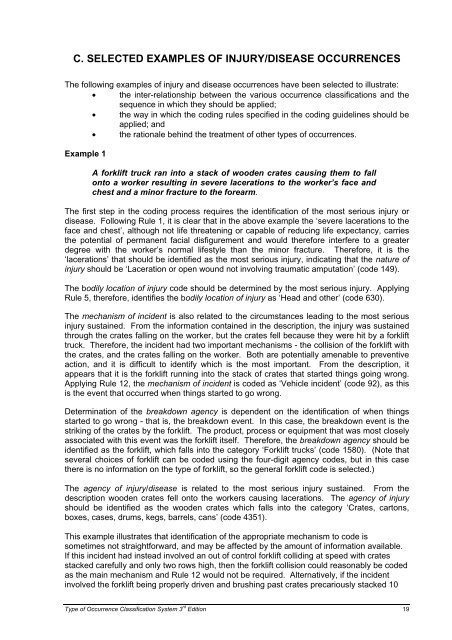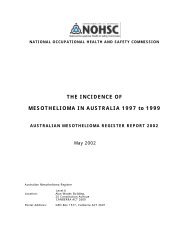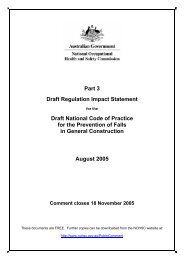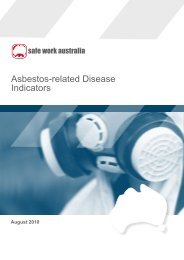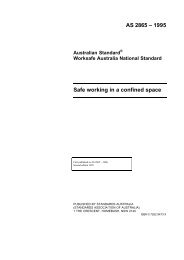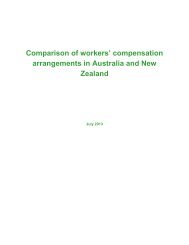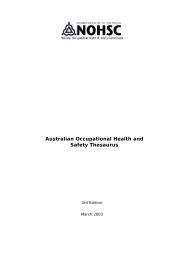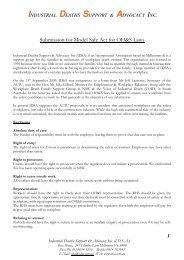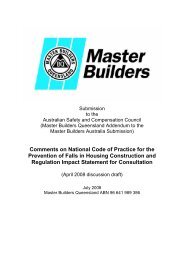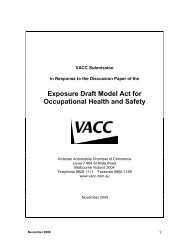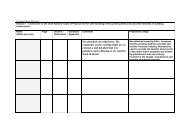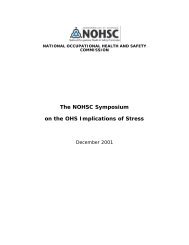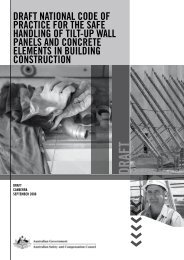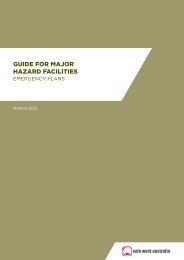Type of Occurrence Classification System - Safe Work Australia
Type of Occurrence Classification System - Safe Work Australia
Type of Occurrence Classification System - Safe Work Australia
You also want an ePaper? Increase the reach of your titles
YUMPU automatically turns print PDFs into web optimized ePapers that Google loves.
C. SELECTED EXAMPLES OF INJURY/DISEASE OCCURRENCESThe following examples <strong>of</strong> injury and disease occurrences have been selected to illustrate:• the inter-relationship between the various occurrence classifications and thesequence in which they should be applied;• the way in which the coding rules specified in the coding guidelines should beapplied; and• the rationale behind the treatment <strong>of</strong> other types <strong>of</strong> occurrences.Example 1A forklift truck ran into a stack <strong>of</strong> wooden crates causing them to fallonto a worker resulting in severe lacerations to the worker’s face andchest and a minor fracture to the forearm.The first step in the coding process requires the identification <strong>of</strong> the most serious injury ordisease. Following Rule 1, it is clear that in the above example the ‘severe lacerations to theface and chest’, although not life threatening or capable <strong>of</strong> reducing life expectancy, carriesthe potential <strong>of</strong> permanent facial disfigurement and would therefore interfere to a greaterdegree with the worker’s normal lifestyle than the minor fracture. Therefore, it is the‘lacerations’ that should be identified as the most serious injury, indicating that the nature <strong>of</strong>injury should be ‘Laceration or open wound not involving traumatic amputation’ (code 149).The bodily location <strong>of</strong> injury code should be determined by the most serious injury. ApplyingRule 5, therefore, identifies the bodily location <strong>of</strong> injury as ‘Head and other’ (code 630).The mechanism <strong>of</strong> incident is also related to the circumstances leading to the most seriousinjury sustained. From the information contained in the description, the injury was sustainedthrough the crates falling on the worker, but the crates fell because they were hit by a forklifttruck. Therefore, the incident had two important mechanisms - the collision <strong>of</strong> the forklift withthe crates, and the crates falling on the worker. Both are potentially amenable to preventiveaction, and it is difficult to identify which is the most important. From the description, itappears that it is the forklift running into the stack <strong>of</strong> crates that started things going wrong.Applying Rule 12, the mechanism <strong>of</strong> incident is coded as ‘Vehicle incident’ (code 92), as thisis the event that occurred when things started to go wrong.Determination <strong>of</strong> the breakdown agency is dependent on the identification <strong>of</strong> when thingsstarted to go wrong - that is, the breakdown event. In this case, the breakdown event is thestriking <strong>of</strong> the crates by the forklift. The product, process or equipment that was most closelyassociated with this event was the forklift itself. Therefore, the breakdown agency should beidentified as the forklift, which falls into the category ‘Forklift trucks’ (code 1580). (Note thatseveral choices <strong>of</strong> forklift can be coded using the four-digit agency codes, but in this casethere is no information on the type <strong>of</strong> forklift, so the general forklift code is selected.)The agency <strong>of</strong> injury/disease is related to the most serious injury sustained. From thedescription wooden crates fell onto the workers causing lacerations. The agency <strong>of</strong> injuryshould be identified as the wooden crates which falls into the category ‘Crates, cartons,boxes, cases, drums, kegs, barrels, cans’ (code 4351).This example illustrates that identification <strong>of</strong> the appropriate mechanism to code issometimes not straightforward, and may be affected by the amount <strong>of</strong> information available.If this incident had instead involved an out <strong>of</strong> control forklift colliding at speed with cratesstacked carefully and only two rows high, then the forklift collision could reasonably be codedas the main mechanism and Rule 12 would not be required. Alternatively, if the incidentinvolved the forklift being properly driven and brushing past crates precariously stacked 10<strong>Type</strong> <strong>of</strong> <strong>Occurrence</strong> <strong>Classification</strong> <strong>System</strong> 3 rd Edition 19


